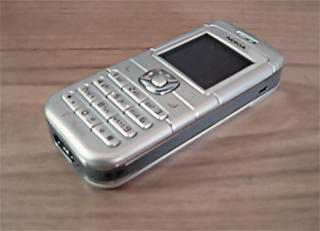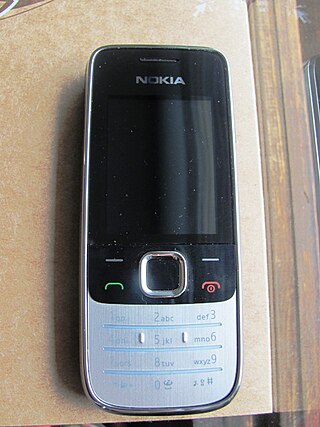Scalable Vector Graphics (SVG) is an XML-based vector image format for defining two-dimensional graphics, having support for interactivity and animation. The SVG specification is an open standard developed by the World Wide Web Consortium since 1999.

Extensible Markup Language (XML) is a markup language and file format for storing, transmitting, and reconstructing arbitrary data. It defines a set of rules for encoding documents in a format that is both human-readable and machine-readable. The World Wide Web Consortium's XML 1.0 Specification of 1998 and several other related specifications—all of them free open standards—define XML.

Wireless Markup Language (WML), based on XML, is an obsolete markup language intended for devices that implement the Wireless Application Protocol (WAP) specification, such as mobile phones. It provides navigational support, data input, hyperlinks, text and image presentation, and forms, much like HTML. It preceded the use of other markup languages used with WAP, such as XHTML and HTML itself, which achieved dominance as processing power in mobile devices increased.
Multimedia Messaging Service (MMS) is a standard way to send messages that include multimedia content to and from a mobile phone over a cellular network. Users and providers may refer to such a message as a PXT, a picture message, or a multimedia message. The MMS standard extends the core SMS capability, allowing the exchange of text messages greater than 160 characters in length. Unlike text-only SMS, MMS can deliver a variety of media, including up to forty seconds of video, one image, a slideshow of multiple images, or audio.
XForms is an XML format used for collecting inputs from web forms. XForms was designed to be the next generation of HTML / XHTML forms, but is generic enough that it can also be used in a standalone manner or with presentation languages other than XHTML to describe a user interface and a set of common data manipulation tasks.
An XML schema is a description of a type of XML document, typically expressed in terms of constraints on the structure and content of documents of that type, above and beyond the basic syntactical constraints imposed by XML itself. These constraints are generally expressed using some combination of grammatical rules governing the order of elements, Boolean predicates that the content must satisfy, data types governing the content of elements and attributes, and more specialized rules such as uniqueness and referential integrity constraints.
OMA SpecWorks, previously the Open Mobile Alliance (OMA) is a standards organization which develops open, international technical standards for the mobile phone industry. It is a nonprofit Non-governmental organization (NGO), not a formal government-sponsored standards organization as is the International Telecommunication Union (ITU): a forum for industry stakeholders to agree on common specifications for products and services.
Push Access Protocol is a protocol defined in WAP-164 of the Wireless Application Protocol (WAP) suite from the Open Mobile Alliance. PAP is used for communicating with the Push Proxy Gateway, which is usually part of a WAP Gateway.
The Extensible Metadata Platform (XMP) is an ISO standard, originally created by Adobe Systems Inc., for the creation, processing and interchange of standardized and custom metadata for digital documents and data sets.

A Push Proxy Gateway is a component of WAP Gateways that pushes URL notifications to mobile handsets. Notifications typically include MMS, email, IM, ringtone downloads, and new device firmware notifications. Most notifications will have an audible alert to the user of the device. The notification will typically be a text string with a URL link. Note that only a notification is pushed to the device; the device must do something with the notification in order to download or view the content associated with it.
Composite Capability/Preference Profiles (CC/PP) is a specification for defining capabilities and preferences of user agents. The delivery context can be used to guide the process of tailoring content for a user agent.
WURFL is a set of proprietary application programming interfaces (APIs) and an XML configuration file which contains information about device capabilities and features for a variety of mobile devices, focused on mobile device detection. Until version 2.2, WURFL was released under an "open source / public domain" license. Prior to version 2.2, device information was contributed by developers around the world and the WURFL was updated frequently, reflecting new wireless devices coming on the market. In June 2011, the founder of the WURFL project, Luca Passani, and Steve Kamerman, the author of Tera-WURFL, a popular PHP WURFL API, formed ScientiaMobile, Inc to provide commercial mobile device detection support and services using WURFL. As of August 30, 2011, the ScientiaMobile WURFL APIs are licensed under a dual-license model, using the AGPL license for non-commercial use and a proprietary commercial license. The current version of the WURFL database itself is no longer open source.

The Nokia 6030, introduced in Q1 2005, is a GSM dual band handset operating on frequencies 900 and 1800 MHz, with automatic switching between frequencies. It is small in size with dimensions of 104 x 44 x 18 mm and weighs 90 grams. It also has 3MB Shared Memory.
Content adaptation is the action of transforming content to adapt to device capabilities. Content adaptation is usually related to mobile devices, which require special handling because of their limited computational power, small screen size, and constrained keyboard functionality.
The Device Description Repository (DDR) is a concept proposed by the Mobile Web Initiative Device Description Working Group (DDWG) of the World Wide Web Consortium. The DDR is supported by a standard interface and an initial core vocabulary of device properties. Implementations of the proposed repository are expected to contain information about Web-enabled devices. Authors of Web content will be able to make use of repositories to adapt their content to best suit the requesting device. This will facilitate the interaction and viewing of Web pages across devices with widely varying capabilities.
Wireless Application Protocol (WAP) is a technical standard for accessing information over a mobile wireless network. A WAP browser is a web browser for mobile devices such as mobile phones that use the protocol. Introduced in 1999, WAP achieved some popularity in the early 2000s, but by the 2010s it had been largely superseded by more modern standards. Almost all modern handset internet browsers now fully support HTML, so they do not need to use WAP markup for web page compatibility, and therefore, most are no longer able to render and display pages written in WML, WAP's markup language.
Mobile web analytics studies the behaviour of mobile website users in a similar way to traditional web analytics. In a commercial context, mobile web analytics refers to the data collected from the users who access a website from a mobile phone. It helps to determine which aspects of the website work best for mobile traffic and which mobile marketing campaigns work best for the business, including mobile advertising, mobile search marketing, text campaigns, and desktop promotion of mobile sites and services.
Extensible HyperText Markup Language (XHTML) is part of the family of XML markup languages. It mirrors or extends versions of the widely used HyperText Markup Language (HTML), the language in which Web pages are formulated.
Novarra was a mobile internet software company founded in 2000 and based in Itasca, Illinois, United States. It created web-based services such as web internet access, portals, videos, widgets and advertising for mobile devices. Novarra provided access to the internet and other services through wireless handsets, PDAs and laptops and sold directly to operators, mobile handset manufacturers and internet brand companies. In 2010, Nokia acquired 100% of Novarra's shares.

The Nokia 2730 classic is a Nokia Quad-band GSM/UMTS 3G cell phone that includes a camera, FM radio, Bluetooth, music and video player, as well as several internet-based applications.




